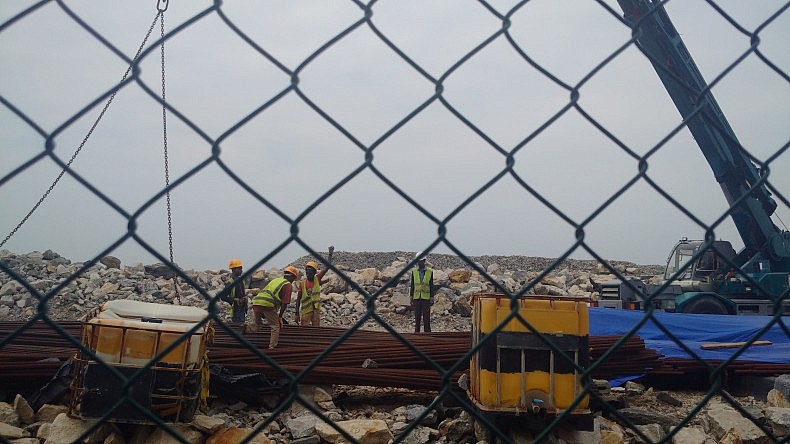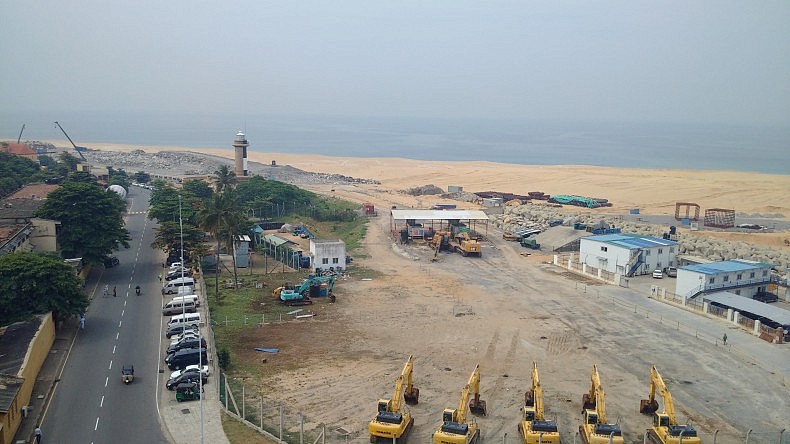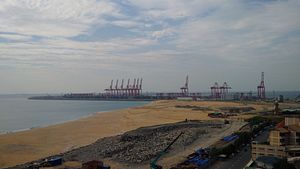At sunset, I had an unimpeded view of a crimson-tinted sea from the rooftop bar of the Kingsbury Hotel in Colombo, Sri Lanka. This hotel, which sits right between the Port of Colombo to the north and the Galle Face Green to the south, is 100 meters from the beach — you can hear the waves crashing against the sand nine stories below. This seaside position could be assumed to be immutable, but it isn’t. In just a few years the Kingsbury will no longer be on the coast. The hotel isn’t going anywhere, but the coastline is.
At the junction of where the Indian Ocean makes landfall with the western coast of Colombo will soon be a new city of towering skyscrapers, luxury hotels, shopping malls, a marina, and even a Formula One track. This new urban conurbation is called Colombo Port City. It is a US$1.4 billion endeavor that is fully backed by Chinese foreign direct investment. The project consists of reclaiming 233 hectares of land from the sea, pulling the beach far out from the foot of the Kingsbury Hotel. This is a project that will not only indelibly alter Colombo’s coastline but also Sri Lanka’s economic position and geopolitical relations with countries from East to West.

People work creating new land in Sri Lanka. Photo by Wade Shepard.
The origin of the Colombo Port City project seems mythical. The story goes that while inspecting the land reclamation progress for the expansion of Colombo’s port, then-president Mahinda Rajapaksa looked out over the newly accumulated sediment and had an epiphany: why not just keep reclaiming land down the coast to build a new city district? However, the reality may have been a little more pragmatic, as the site of the impending port city was silting up naturally to the south of the new container terminal anyway.
Construction on Colombo Port City initially began in March 2011, but due to various reasons it was put on hold. The project was then re-launched in September 2014 with a grandiose commencement ceremony that featured both Mahinda Rajapaksa and Chinese President Xi Jinping.
Although Colombo Port City was conceived by Sri Lanka and was at first developed by a local company, it is now an almost 100 percent Chinese undertaking. The financial backing for the project comes via foreign direct investment from China Harbor Engineering Corporation, a subsidy of the World Bank-blacklisted China Communications Construction, a Chinese state-owned enterprise. This is the largest single example of FDI in Sri Lanka ever. Whereas many of China’s other investments in Sri Lanka come in the form of loans, China intends to directly reap the spoils from Colombo Port City. In the initial conception of the project, China and Sri Lanka would have equal rights to the port city, but due to concerns over sovereignty and appeals from India, this was eventually changed into a 99-year lease over a portion of the newly fabricated land.
“In a sense you can say that this is Chinese diplomacy, China’s way of trying to engage with all of these countries by providing infrastructure financing and developing some of these key ports along the Silk Route, the One Belt One Road initiative,” said Dushni Weerakoon, a researcher at Colombo’s Institute of Policy Studies.
Once built, Colombo Port City will essentially become a quasi extra-territorial zone that will have some of its own favorable laws and regulations regarding trade and investment. It will become a place where traders from around the world can come, invest, and do business, right in the heart of the Indian Ocean theater.
How will this benefit Sri Lanka?
“Investment,” Deshal de Mel, a senior economist at Hayleys Plc in Colombo replied without hesitation. “I mean, you’re creating a new investment in development, in finance, and a number of things, which will create jobs.”
It’s the position of Sri Lanka that makes it of interest to the Chinese. Hovering at the tip of the Indian subcontinent on the busiest shipping lane in the world, right between East Asia, the Middle East, and Africa, Sri Lanka has always been a clutch trading hub. This is why Colombo Port City is be one of the most prominent financial and commercial centers on what has been dubbed the 21st Century Maritime Silk Road, the sea-based portion of China’s Belt and Road, pan-Eurasia investment strategy.

View of land reclamation in Colombo, Sri Lanka. Photo by Wade Shepard.
I watched the land reclamation process from temple tower that rises over the impending port city. The process is surprisingly straightforward: a crescent-shaped, stone partitioning wall was built out from the coast along the desired parameters of the port city which gradually traps sediment that will eventually become solid land. A row of backhoes were lined up in front of two white corrugated steel laborer dormitories that had red Chinese characters painted upon them.
China has done this before. Land has been being reclaimed in China since at least the Qing Dynasty (1644-1911), when river and coastal sediments were corralled to make more land for farming, salt production, and aquaculture. Today, up to 700 square kilometers of land is being reclaimed up and down the coast of mainland China each year, and entirely new cities and ports are being built upon this new land. Making land makes money — up to a hundredfold profit, according to Liu Hongbin, a professor at the Ocean University of China — and increases the reach of potential urban expansion.
However, the Colombo Port City project has not been without controversy. Amid geopolitical and sovereignty concerns, the project has been called an “environmental time bomb” that could do widespread damage the coastal belt.
Geopolitically speaking, India has not been particularly enamored with China moving into what it perceives as its backyard with Belt and Road infrastructure projects in Bangladesh, Sri Lanka, the Maldives, and Pakistan — essentially surrounding the country in a “String of Pearls.” The apprehension is that these apparently commercial projects could serve other, potentially militaristic, purposes as well — these fears were in no way assuaged when Chinese submarines and a warship called into the Chinese-operated Colombo South Port in 2014.
“They felt that the particularities of the most controversial project was the Port City project,” Deshal de Mel explained. “So there China would be, a Chinese company would be getting land that is reclaimed from the sea and equal rights to part of it and so on. So that was controversial in India and they felt that there was a risk that China is going to have naval interests and a security presence there and how that would affect India’s own geopolitical position.”
However, the reasons for the Rajapaska regime’s proclivity for finding Chinese partners for his infrastructure and investment projects wasn’t exactly due to a personal preference but as a reaction to political and economic pressure from the West. Between the 2006 and 2009, the EU and U.S. shut down most economic concessions and sources of aid to Sri Lanka to demonstrate their disapproval of alleged abuses that transpired during the final stages of the country’s decades long civil war. Dubbed war crimes, the Sri Lankan government was called up before the UN Human Rights council and in 2009, when the EU’s GSP-Plus trade concessions to Sri Lanka came up for renewal, an ultimatum in the form of a full list of human rights related demands was issued. Sri Lanka declined to engage and the concessions were therefore discontinued. On the same grounds, the United States also cut back on many sources of aid.
“Then China came in and filled that diplomatic vacuum,” Weerakoon said.
While the West tried to exert political and economic pressure on Sri Lanka to force the country to atone for alleged humanitarian abuses, what they actually did was push the country into a closer alliance with China. As sources of Western funding dwindled, China made up the difference and then some, pumping the country with over $4.8 billion in soft loans destined for infrastructural development.
“China has a hands off approach,” Weerakoon explained. “It will give you money and let you do what you want to do. They won’t lecture you on humans rights.”
In the years that followed, Sri Lanka basically became an outpost for Chinese development. In addition to the proposed Port City, Chinese-backed highways, ports, airports, convention centers, and even stadiums began proliferating over the country. Although the details of many of these projects were extremely murky and, allegedly, extremely corrupt. Notable examples of potential misuses of funds were the Colombo-Katunayake Expressway which cost at least US$11.5 million per kilometer, at that time one of the most expensive highways ever built, as well as a large boulder that apparently cost US$42 million to remove from Colombo Harbor.
Eventually, this blatant misuse of power triggered a strong opposition within the country, and during Sri Lanka’s 2015 presidential elections a formidable political opponent rose up to challenge Rajapaksa’s omnipotent-seeming rule. Maithripala Sirisena ran on a platform of national rejuvenation, accusing the incumbent of unabashed corruption and for trashing the country’s relations with India and the West. During his campaign, the Port City project became a symbol of Rajapaksa’s scandalous rule, with opposition stating clearly that if they won the project would be scrapped.
It was an effective strategy and the challenging party unexpectedly won. One of the first things that the new president did upon taking office in early 2015, besides putting down an alleged coup by the losing candidate, was setting to work “realigning” Sri Lanka’s international relations. As a starting point, he pulled the plug on many big Chinese-backed projects. Construction on the Hambantota deep sea port was stalled, flights to Hambantota International Airport by Sri Lanka’s flagship carrier were canceled, and the development of Colombo Port City was shut down. Officially, the new government said that these projects were being put on hold until they had the opportunity to investigate the real nature of the deals and to conduct the relevant impact assessments.
“So our government’s relations with China sort of lapsed,” Weerakoon said of the inevitable knee-jerk reaction from this realignment.
Needless to say, China was not pleased, and expressly stated that failure to continue the Port City project in particular could have drastic ramifications on broader Chinese investment and aid coming to the country.
During this period the new Sri Lankan government was hoping for two things: to have the UN go easier on the war crimes issue as well as to get back the Western incentives and aid the country previously lost. These two moves have largely proved successful. In September 2015, the UN’s Office of the High Commissioner for Human Rights released a new report of their investigations into Sri Lanka’s alleged war crimes which many human rights advocates felt left something to be desired. The New York Times summed up this sentiment, deeming that the report was “arresting for the disconnect between the seriousness of the abuses it documents and the mildness of its recommendations.” While the EU has recently stated that they are now open to reinstating Sri Lanka’s GSP-Plus trade concessions and the United States began upping their incentives and aid once again.
All the while, Sri Lanka kept China on the back burner. But now that relations are improving with the West, Sri Lanka has begun looking back East to mend their recently ruptured relationship with China as well. In practice, this meant starting their previous big infrastructure projects back up again. Construction restarted on phase two of the Hambantota deep sea port, highways continued being built, and the Colombo Port City project is back online.
“They are going back because they’ve woken up to the realities of geopolitics,” Weerakoon stated. “Because the Americans or the Indians they don’t have that kind of financing to offer… the sources of capital are from China.”
Sri Lanka’s central position between the East and West is one of its prime advantages, but it is also the source of some of its largest challenges. Being geopolitically located between India, China, Japan, the EU, and the United States means continuously tiptoeing through a proverbial hen house without ruffling any feathers.
“It’s up to the Sri Lankan government to make sure that they don’t play the two [sides] against each other and to try to balance their interests and make the best of the economic and political options that they have,” de Mel concluded.
As I sat waiting in Colombo’s Bandaranaike International Airport waiting for my flight to depart, my gaze fell upon a television screen that had a promotional video for Colombo Port City running on a continuous loop. The government’s abrupt change in position was clearly not something that they intended to hide. The next time I stand on the rooftop of the Kingsbury Hotel the view will more than likely be very much changed.
Wade Shepard is a journalist and author of Ghost Cities of China.

































